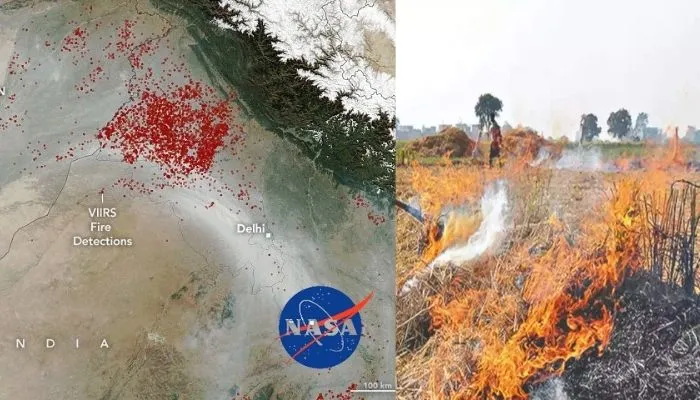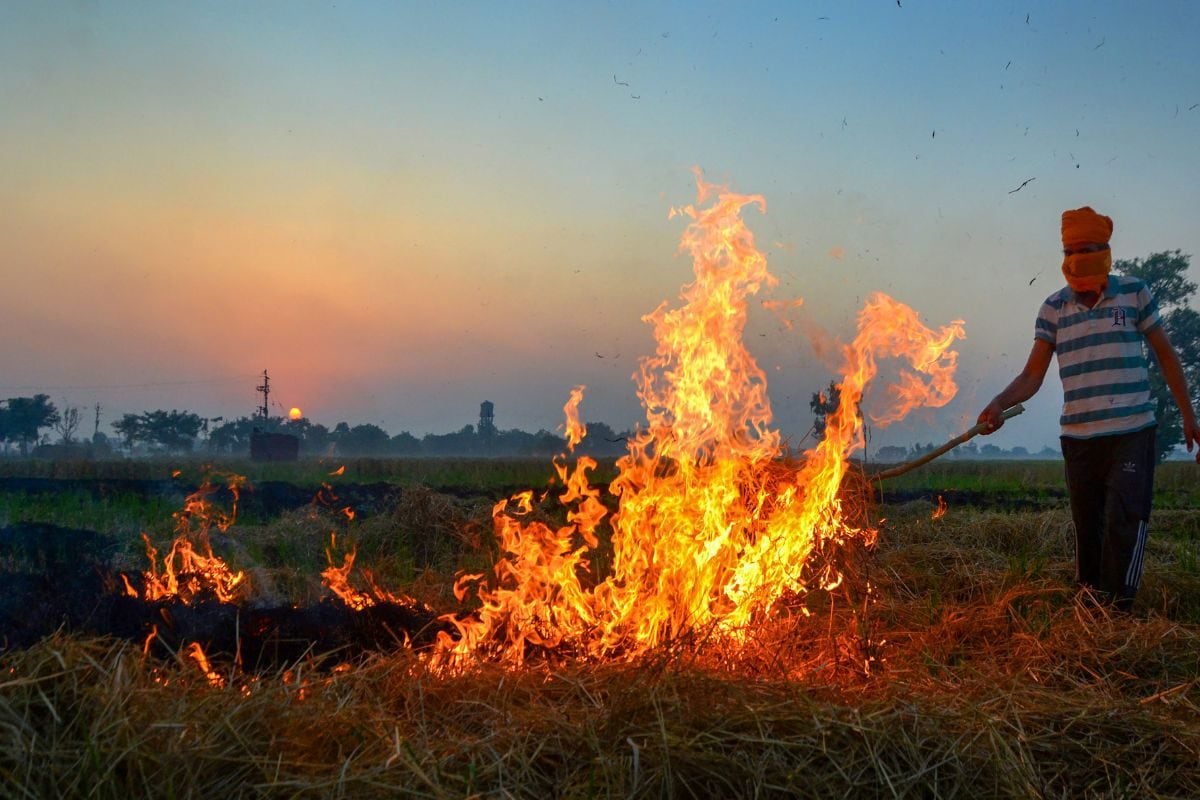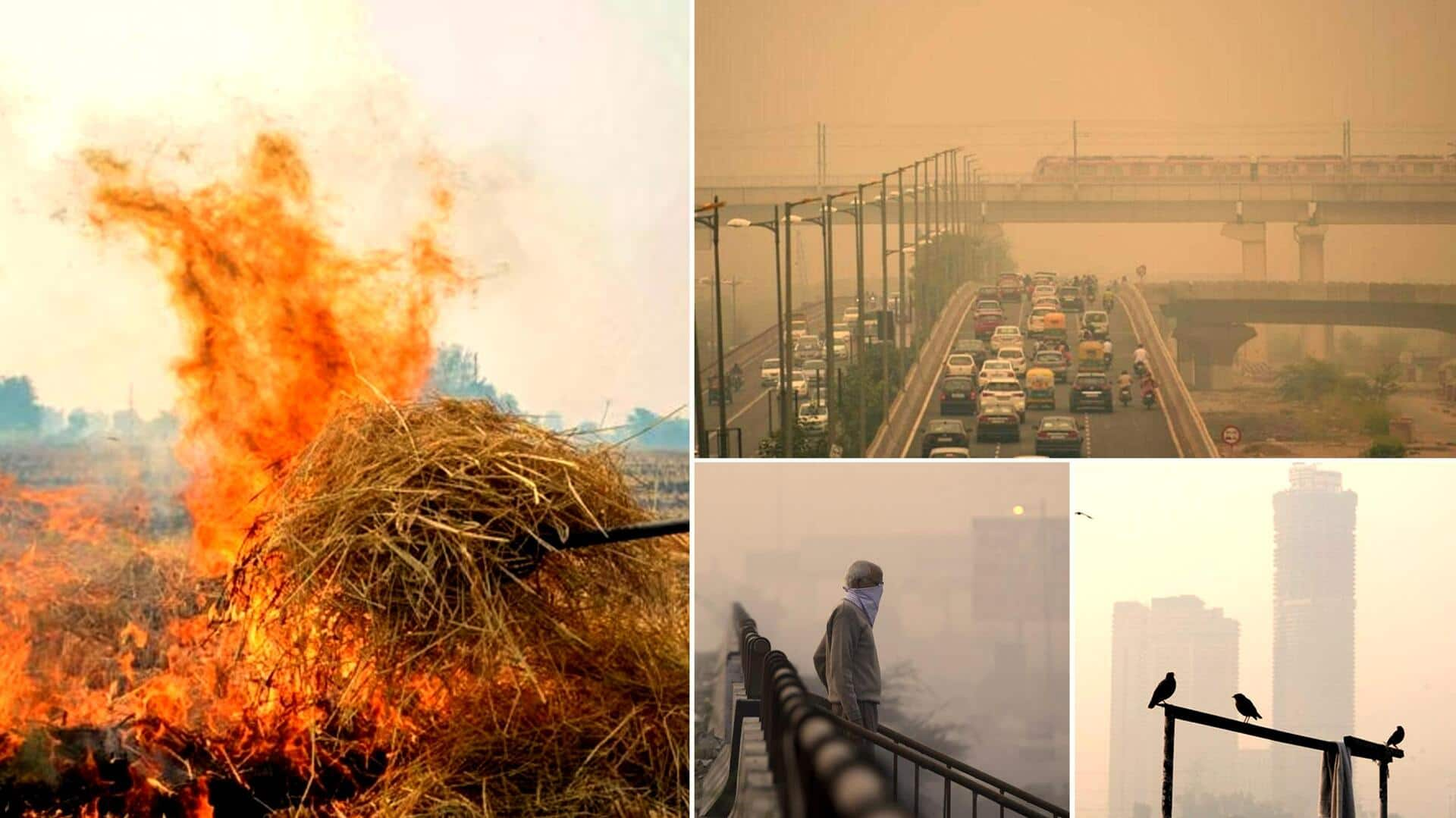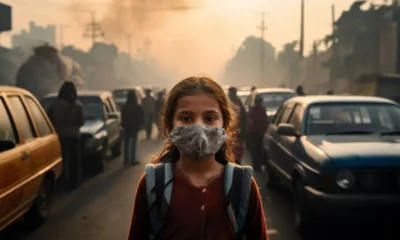Climate Journalism
Why Are Stubble Burning Farmers Not Convinced That Their Act Is A Serious Health Hazard. Looking Deeper The Answers Are Many And Extremely Complicated.
Published
11 months agoon

Delhi’s air is thick with smog, and so is the debate around stubble burning. Today, November 19, 2024, Delhi’s air quality has spiraled to a shocking level — more than 17 times above what’s considered safe. The city’s toxic air isn’t just a local issue; it’s a crisis that echoes across the fields of Punjab, Haryana, and other northern states.
Despite being branded as the main culprits behind Delhi’s deteriorating air quality, farmers in these regions seem unfazed. Why? Why do they continue a practice everyone from scientists to courts has flagged as dangerous? The answers, as we dig deeper, are not simple. They’re layered, complex, and tied to systemic challenges.
The Dilemma of the Farmer
For farmers, stubble burning isn’t about willful negligence—it’s about survival. The practice is a quick, cheap way to clear fields of paddy crop residue so wheat can be sown in time. With a narrow sowing window, no practical alternatives, and limited financial incentives, many farmers feel their hands are tied.
To them, the haze over Delhi is collateral damage, not a deliberate act of harm. However, the scene shifts when experts claim farmers are now deceiving the system. Recent revelations suggest that farmers might be gaming satellite monitoring to underreport incidents of stubble burning. If true, this tactic complicates efforts to combat pollution and raises questions about accountability.
Manipulating the System: Satellites and Stubble
Punjab, often the poster child for farm fires, has shown a significant decline in reported incidents — from about 79,000 in 2021 to just 32,000 in 2023. This year, as of November 10, Punjab recorded a mere 6,611 fires, the lowest in five years. Haryana has also shown a sharp drop. At first glance, this data looks promising. But dig deeper, and you’ll find the cracks.
Farmers are allegedly altering their burning schedules to avoid detection by NASA’s satellites, which track fires during specific timeframes (10:30 AM to 1:30 PM). A Korean stationary satellite operating at 4:20 PM revealed unreported fires, suggesting many incidents are missed by traditional monitoring methods. The discrepancy was brought to the fore during a Supreme Court hearing, where Senior Advocate Aparajita Singh pointed out gaps in satellite data accuracy.
Analysis, supported by aerosol data (a measure of pollutants like carbonaceous smoke), reveals a persistent and even heightened presence of atmospheric pollution. This inconsistency raises an unsettling possibility: fire incidents might not be declining but merely avoiding satellite detection during their scheduled passes, typically between 10:30 AM and 1:30 PM. Ground-level smoke patterns observed by stationary satellites in the late afternoon corroborate this theory.

It’s Not Just Punjab and Haryana
While the spotlight remains on Punjab and Haryana, states like Uttar Pradesh, Rajasthan, Madhya Pradesh, and even Delhi have seen a rise in stubble-burning incidents. Researchers from the Centre for Science and Environment (CSE) have flagged a stark, often overlooked reality: biomass burning isn’t just a northern phenomenon. Satellite imagery reveals a nation-wide issue, with dense clusters of fires dotting central, northeastern, and even parts of southern India.
Anumita Roychowdhury from CSE describes it as an alarming “fire map” spanning much of India and parts of Southeast Asia. These fires—crop residue, forest biomass, or other materials—highlight a systemic problem that goes beyond seasonal stubble burning in a few states.
A Shifting Pattern in Biomass Burning
A closer look at India’s satellite imagery tells a troubling story. Bright dots—concentrated in Madhya Pradesh, Chhattisgarh, Odisha, Jharkhand, Punjab, Haryana, Uttar Pradesh, Rajasthan, and even parts of southern India—mark areas where biomass is being burned. Traditionally, these fires peak between November and December, after the monsoon paddy harvest, with close to 80% of crop residue burning occurring during this period. Punjab and Haryana have long been at the center of this issue, given their impact on Delhi’s air quality.
But the pattern is changing. Unofficial trends now point to a new season of stubble burning: April to May. What’s different this time is the crop involved—wheat, not paddy. Even more concerning, this practice has spread beyond Punjab and Haryana to other states.
This raises a critical question: Why are farmers burning wheat residue when there’s no immediate time crunch? After all, wheat harvesting in April leaves farmers with a two-month gap before the monsoon crop planting begins. Moreover, wheat residue holds significant value as fodder, especially in a country facing a 22% fodder shortage. On paper, burning wheat stubble appears unnecessary. So, what’s driving this shift?
The Economics of Burning: A Farmer’s Perspective
For farmers in Madhya Pradesh’s, the answer is simple: cost. “If I can clear my farm using a one-rupee matchbox, why will I spend thousands?” asks one farmer. Preparing his fields for the soybean crop in June means clearing stubble quickly and efficiently. However, the labour force that once managed this task has dwindled. “A decade ago, there were around 400 labourers in the village, but they’ve migrated for better opportunities. Labour costs are very high now,” he adds.
Mechanisation has filled the gap, but it has come with its own set of challenges. Another farmer with over 10 hectares in the same village, explains that combine harvester machines have become essential due to labour scarcity. These machines perform reaping, threshing, and winnowing in hours, making them economical. However, they leave behind stubble—40 cm stalks of residue—which must either be manually removed or dealt with using additional machinery.
Here lies the dilemma: while renting a combine harvester costs just ₹800 per 0.4 hectares, clearing the stubble can cost as much as ₹3,500 per hectare. For many farmers, the math is simple: burning is cheaper.
The Combine Harvester Effect
The widespread adoption of combine harvesters is fueling this problem. In districts like Harda, where irrigation is abundant and farmers grow three crops a year, the pressure to clear fields quickly is immense. According to Kedar Sirohi of the Aam Kisan Union, the number of combine harvesters in Harda has surged to over 250 in the past five years, primarily due to labour shortages.
“Earlier, most combine harvesters here were brought in from Punjab and Haryana,” Sirohi notes. “Now, they’re everywhere in Harda.” The efficiency of these machines in harvesting grain is undeniable, but the leftover stubble, which requires additional effort and expense to clear, is fueling a new wave of crop residue burning.
A Growing Crisis
Traveling across Madhya Pradesh reveals the scale of the issue. Reports of uncontrolled fires, often destroying standing crops, are increasingly common. In Harda, the situation has become so dire that the district collector has invoked Section 144 of the Indian Penal Code to prohibit stubble burning. Yet, enforcement is proving difficult. Farmers like Ankit and thousands of others view the practice as a necessary shortcut to manage tight schedules and rising costs.
The problem isn’t confined to Harda. Across India, districts with intense cropping patterns, ample irrigation, and high levels of mechanisation are grappling with wheat stubble fires. While data on state-wide incidents remains fragmented, the trend is clear: biomass burning is no longer a seasonal or regional issue.

The Expanding Footprint of Crop Residue Burning in Madhya Pradesh and Beyond
As irrigation networks expand across Madhya Pradesh, agricultural acreage has grown, bringing with it a proportionate rise in crop residue burning. The practice is especially common in crop-intensive districts such as Hoshangabad, Sehore, and Vidisha. With Madhya Pradesh accounting for nearly 15% of India’s 29.7 million hectares of wheat cultivation, it generates an estimated 33 million tonnes of crop residue annually, 80% of which comes from cereal crops like wheat and paddy. Of this, approximately 3.86 million tonnes are burned on farms each year.
In 2014, environmental activist Subhash C. Pandey filed a petition with the Bhopal bench of the National Green Tribunal (NGT), urging the establishment of a mechanism to ban crop residue burning. The NGT tasked the Madhya Pradesh Pollution Control Board (MPPCB) with assessing the environmental impact of the practice.
However, a rapid pilot study by MPPCB surprisingly concluded that there was no significant effect on the local ecosystem. “The rapid pilot study of burning agricultural residues reveals that no significant effect was observed on the local ambient environment,” said Reeta Kori, chief scientist at MPPCB. This finding meant that no immediate government action was taken.
Critics, however, argue that these assessments were insufficient. N.P. Shukla, a former chairperson of MPPCB and member of the Ministry of Environment, Forest, and Climate Change’s expert appraisal committee, noted that the studies primarily focused on preliminary ambient air quality. Recent research tells a different story, showing that particulate matter (PM) 2.5 and PM 10 levels often exceed prescribed limits.
Why Residue Burning is on the Rise
Two major factors are fueling the rise of crop residue burning in the April-May period: the increasing spread of wheat cultivation and the adoption of mechanised farming. Arun Sharma, a professor of agronomy at Agriculture University, Kota, explains that mono-cropping of wheat—a cash crop—is a key driver of the problem, especially in regions like Rajasthan.
The shift is stark when compared to two decades ago, when crop residue burning in Rajasthan was far less prevalent. Today, the rising popularity of wheat farming in India’s desert regions is visible, especially along routes like the Kota-Ajmer highway. As one approaches Kota, an unmistakable haze hangs over charred farmlands—a consequence of burning wheat stubble and biomass, a practice that has become increasingly common in recent years. Between 2002 and 2006, the average area under wheat cultivation in the region was 313,269 hectares. By 2015, this had more than doubled.
Mechanisation. A Double-Edged Sword
Mechanised farming has revolutionized agricultural productivity but has also exacerbated the problem of crop residue. Combine harvesters, widely used across the region, leave behind sharp stubble that is challenging to remove manually and unsuitable for animal fodder.
For farmers like Rakesh Prajapati, who cultivates two hectares in Arjunpura village near Kota, burning the residue is often the only viable solution. “The problem with the leftover straw and stubble is that it floats on water after the monsoon, preventing paddy from germinating,” he explains. However, not all farmers can burn their stubble—it requires careful management of the flames, which only those with larger fields or strategically located plots can afford to attempt.
The situation is equally dire in nearby villages like Chandresal, where residents lament the loss of traditional practices. “The cuttings left by machines are too sharp. They injure us, and animals struggle to graze on them,” says Shital Devi, a farmer from Chandresal. “In any case, there is barely any fodder left in these cuttings,” adds Gurucharan Singh, another farmer from the same village.
A State in Denial
Despite clear evidence from satellite imagery showing widespread stubble burning in Uttar Pradesh, the Uttar Pradesh State Pollution Control Board (UPPCB) claims the practice is negligible. In April this year, only one complaint of stubble burning was officially lodged, from Gautam Budh Nagar district. However, ground realities tell a different story.
During a visit to Gorakhpur—one of the areas flagged by NASA imagery and home to Chief Minister Yogi Adityanath—it became evident that the UPPCB does not actively monitor the impact of residue burning on air quality.
According to T.N. Singh, Assistant Scientific Officer at UPPCB’s Gorakhpur office, the city’s three monitoring stations operate just one day a month to assess pollution levels. When asked about air quality trends, Singh admitted that April’s data had not yet been processed. While a fine of ₹5,000 exists for burning crop residue, reports of the practice persist in Gorakhpur and neighboring districts like Deoria and Maharajganj.

Fodder Scarcity and Agrarian Conflicts
Conversations with Gorakhpur farmers revealed a surprising factor behind stubble burning—fodder scarcity is driving agrarian conflicts. Farmers rely on threshing machines to process leftover crop residue into usable fodder. They pay machine owners to clear their fields, expecting adequate fodder in return. However, threshing often produces insufficient fodder to meet demand.
This scarcity has led to tensions among farmers, occasionally resulting in deliberate stubble fires. In Simra village, farmer Motilal Yadav recounted how fire from an adjacent field spread uncontrollably, burning his 40 cm wheat stubble and damaging 80 hectares of farmland, including parts of Shioria village. The situation escalated to the point where fire brigades were called. Fear of retaliation keeps villagers from naming those responsible for starting fires, as noted by Balwant Yadav from Shioria.
Another theory links the fires to threshing machines themselves. Farmers like Neeraj Yadav, who owns a threshing machine in Ghunghun Kotha village, acknowledge that sparks from the machines could unintentionally ignite fires.
A Widening Problem Across States
What began as an issue predominantly in Punjab and Haryana has now spread to Madhya Pradesh, Rajasthan, and Uttar Pradesh. The cycle is fueled by agricultural intensification: irrigation improvements boost yields, leading farmers to adopt multi-cropping for higher profits. This leaves little time between harvests, encouraging the use of mechanized farming to save labor and time.
For example, Punjab farmers face a mere 15-20 day gap between harvests, while in Madhya Pradesh, the window is slightly longer at 30 days. Burning residue becomes the fastest and most cost-effective solution.
The mechanization of Indian agriculture has grown significantly over the decades. By 2012-13, the country had 3.15 million tractors and 477,000 combine harvesters, with tractor usage surging from 6.8% in the 1970s to 45.8%. However, while mechanization boosts productivity, it has also reduced reliance on traditional labor and draught animals.
India’s import of $440 million worth of farming equipment in 2015, including power tillers and post-harvest tools, highlights the growing dependence on technology. In Madhya Pradesh alone, the number of combine harvesters has more than doubled in six years, now standing at approximately 2,500.
But mechanization comes with challenges. The cost of advanced machinery is often prohibitive for small farmers, and residue left by machines has limited economic value. According to P. Indira Devi, Director of the Centre of Excellence in Environmental Economics, Kerala Agricultural University, paddy straw is declining as livestock feed due to its high silica content, while wheat straw is sometimes rejected due to contamination from fuel spills during mechanized harvesting.
The Growing Crisis of Crop Burning
As the crop-burning season begins, it inevitably raises concerns about its devastating impact on air quality and public health. According to a study by the Indian Agricultural Research Institute (IARI), crop residue burning in 2008-09 alone released 149.24 million tonnes of carbon dioxide (CO2), over 9 million tonnes of carbon monoxide (CO), 0.25 million tonnes of sulphur oxides (SOX), 1.28 million tonnes of particulate matter, and 0.07 million tonnes of black carbon.
These emissions have a far-reaching impact. For instance, particulate matter from crop burning is over 17 times the total annual PM pollution in Delhi, while CO2 emissions are more than 64 times Delhi’s annual levels. Similarly, sulphur oxide emissions from crop burning nationwide are about five times higher than Delhi’s annual SO2 levels.
These pollutants lead to a host of health issues. A study by the Institute for Social and Economic Change in Bengaluru estimated that rural Punjab residents spend ₹7.6 crore annually on treatments for illnesses caused by stubble burning. Moreover, fine particulate matter linked to haze has been implicated in the alarming retreat of Himalayan glaciers.
A study published in SpringerBriefs in Environmental Science revealed that one year’s crop residue burning in Punjab produces 22 million tonnes of CO2 in just 15–20 days. Dangerous carbon monoxide concentrations—nearly 30 times the permissible limit—have been recorded near burning fields. Emissions of nitrogen oxides and ammonia during these fires further exacerbate the problem. Notably, a ban on stubble burning in the UK significantly reduced ammonia emissions, highlighting the potential benefits of stricter regulation.
The Impact on Soil Health
Crop burning doesn’t just pollute the air; it also degrades the soil. Burning one tonne of rice straw depletes 5.5 kg of nitrogen, 2.3 kg of phosphorus, 25 kg of potassium, and 1.2 kg of sulphur—nutrients essential for soil fertility. Additionally, the intense heat from burning penetrates the soil surface, killing vital microbial populations. According to estimates, Punjab’s farmers lose ₹800–2,000 crore annually due to nutrient loss and ₹500–1,500 crore in the form of subsidies for fertilisers that could have been replenished naturally.
Alternatives to Crop Burning
Farmers have options to manage crop residue, including tilling it back into the soil, baling it for biomass power plants, or using specialised machinery. However, these alternatives face significant challenges.
Rotavators: These machines mulch crop residue into the soil but are expensive (₹1.5 lakh) and costly to rent.
Straw Management Systems (SMS): The Punjab government has mandated SMS installation on combine harvesters, but manufacturers argue this will increase costs and reduce sales.
Lemken Hal Ploughs: These can bury stubble deeper into the soil but are costly (₹2 lakh) and unsuitable for all soil types.
The Happy Seeder, developed by the Punjab government and CSIRO, allows wheat planting through stubble. While effective, it remains unaffordable for many small and marginal farmers. Policies like the National Green Tribunal (NGT) directive of 2015 mandate states to provide subsidised equipment, but implementation has been sluggish.
Biomass as a Sustainable Solution
Efforts to convert stubble into biomass for power generation are gaining traction. For example, a power plant in Patiala generates 12 MW using 120,000 tonnes of stubble annually, collected from 15,000 farmers. However, Punjab’s power surplus limits the expansion of such initiatives, with only a fraction of the available stubble being utilised for biogas production.
Other innovative uses include pelletisation for fuel or as a substrate for mushroom cultivation, but these efforts remain small-scale. A decentralised procurement system for crop residue is essential to make these alternatives viable.
Global Lessons
India is not alone in struggling with crop burning. The UK banned the practice in 1993, with exceptions for research and pest control, while China penalises officials in areas where burning occurs, collecting millions in fines annually. However, the Food and Agriculture Organization highlights that lack of funding hampers the implementation of effective programmes globally.
As Roychowdhury of the Centre for Science and Environment aptly notes, “Pollution knows no boundaries. The air pollution caused by large-scale residue burning affects all of us, regardless of whether we live in Delhi or Harda.” To combat this environmental and public health crisis, a combination of strict enforcement, technological innovation, and farmer support is essential.




